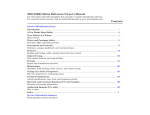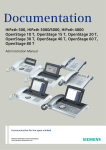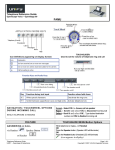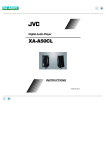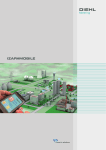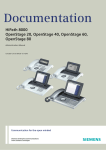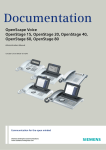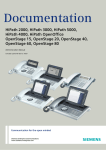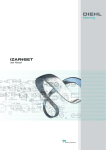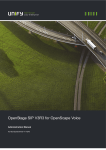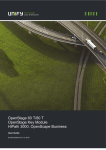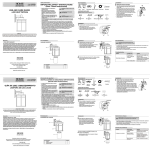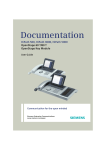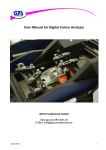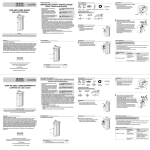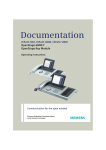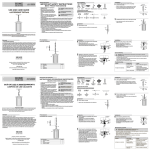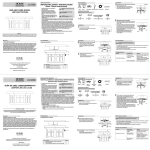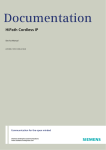Download OpenStage 60 T/80 T - HiPath 3000/5000, HiPth 4000
Transcript
Documentation HiPath 3000/5000, HiPath 4000 OpenStage 60 T, OpenStage 80 T Administration Manual DRAFT Communication for the open minded Siemens Enterprise Communications www.siemens.com/open bkTOC.fm Nur für den internen Gebrauch Content Content 0 1 Overview . . . . . . . . . . . . . . . . . . . . . . . . . . . . . . . . . . . . . . . . . . . . . . . . . . . . . . . . . . . . 1.1 Important Notes . . . . . . . . . . . . . . . . . . . . . . . . . . . . . . . . . . . . . . . . . . . . . . . . . . . . . . 1.2 About the Manual. . . . . . . . . . . . . . . . . . . . . . . . . . . . . . . . . . . . . . . . . . . . . . . . . . . . . 1.3 OpenStage 60 T/80 T user interface . . . . . . . . . . . . . . . . . . . . . . . . . . . . . . . . . . . . . . 1.4 Administration . . . . . . . . . . . . . . . . . . . . . . . . . . . . . . . . . . . . . . . . . . . . . . . . . . . . . . . 1.4.1 HiPath Communication System. . . . . . . . . . . . . . . . . . . . . . . . . . . . . . . . . . . . . . . 1.4.2 Local Menu . . . . . . . . . . . . . . . . . . . . . . . . . . . . . . . . . . . . . . . . . . . . . . . . . . . . . . 1.4.3 OpenStage Manager . . . . . . . . . . . . . . . . . . . . . . . . . . . . . . . . . . . . . . . . . . . . . . . 1-1 1-1 1-2 1-3 1-4 1-4 1-4 1-4 2 Startup . . . . . . . . . . . . . . . . . . . . . . . . . . . . . . . . . . . . . . . . . . . . . . . . . . . . . . . . . . . . . . 2.1 Prerequisites . . . . . . . . . . . . . . . . . . . . . . . . . . . . . . . . . . . . . . . . . . . . . . . . . . . . . . . . 2.2 Assembling and Installing the Phone. . . . . . . . . . . . . . . . . . . . . . . . . . . . . . . . . . . . . . 2.2.1 Shipment . . . . . . . . . . . . . . . . . . . . . . . . . . . . . . . . . . . . . . . . . . . . . . . . . . . . . . . . 2.2.2 Assembly. . . . . . . . . . . . . . . . . . . . . . . . . . . . . . . . . . . . . . . . . . . . . . . . . . . . . . . . 2.2.3 Connectors at the bottom side . . . . . . . . . . . . . . . . . . . . . . . . . . . . . . . . . . . . . . . 2.2.4 Connecting the Phone. . . . . . . . . . . . . . . . . . . . . . . . . . . . . . . . . . . . . . . . . . . . . . 2.2.5 Power supply. . . . . . . . . . . . . . . . . . . . . . . . . . . . . . . . . . . . . . . . . . . . . . . . . . . . . 2-1 2-1 2-1 2-1 2-1 2-2 2-2 2-3 3 Administration . . . . . . . . . . . . . . . . . . . . . . . . . . . . . . . . . . . . . . . . . . . . . . . . . . . . . . . 3-1 3.1 Access to Local Phone Menu . . . . . . . . . . . . . . . . . . . . . . . . . . . . . . . . . . . . . . . . . . . 3-1 3.2 IP Address . . . . . . . . . . . . . . . . . . . . . . . . . . . . . . . . . . . . . . . . . . . . . . . . . . . . . . . . . . 3-3 3.3 Password timeout . . . . . . . . . . . . . . . . . . . . . . . . . . . . . . . . . . . . . . . . . . . . . . . . . . . . 3-3 3.4 Bluetooth adapter . . . . . . . . . . . . . . . . . . . . . . . . . . . . . . . . . . . . . . . . . . . . . . . . . . . . 3-3 3.5 Dialing . . . . . . . . . . . . . . . . . . . . . . . . . . . . . . . . . . . . . . . . . . . . . . . . . . . . . . . . . . . . . 3-4 3.5.1 Canonical Dialing Settings . . . . . . . . . . . . . . . . . . . . . . . . . . . . . . . . . . . . . . . . . . 3-4 3.5.2 Canonical Dial Lookup . . . . . . . . . . . . . . . . . . . . . . . . . . . . . . . . . . . . . . . . . . . . . 3-7 3.6 Pixel saver . . . . . . . . . . . . . . . . . . . . . . . . . . . . . . . . . . . . . . . . . . . . . . . . . . . . . . . . . . 3-9 3.7 Display General Phone Information . . . . . . . . . . . . . . . . . . . . . . . . . . . . . . . . . . . . . . . 3-9 3.7.0.1 Software ver. . . . . . . . . . . . . . . . . . . . . . . . . . . . . . . . . . . . . . . . . . . . . . . . . . 3-9 3.7.0.2 Last restart . . . . . . . . . . . . . . . . . . . . . . . . . . . . . . . . . . . . . . . . . . . . . . . . . . . 3-9 3.8 Password . . . . . . . . . . . . . . . . . . . . . . . . . . . . . . . . . . . . . . . . . . . . . . . . . . . . . . . . . . 3-10 3.9 Factory Reset . . . . . . . . . . . . . . . . . . . . . . . . . . . . . . . . . . . . . . . . . . . . . . . . . . . . . . 3-10 3.10 Restart Phone . . . . . . . . . . . . . . . . . . . . . . . . . . . . . . . . . . . . . . . . . . . . . . . . . . . . . 3-10 A31003-S2000-M101-1-A9, 20/03/2008 HiPath 3000/5000, HiPath 4000 - OpenStage 60 T/80 T, Administration Manual DRAFT 0-1 bkTOC.fm Content Nur für den internen Gebrauch 4 Examples and HowTos . . . . . . . . . . . . . . . . . . . . . . . . . . . . . . . . . . . . . . . . . . . . . . . . . 4.1 Canonical Dialing . . . . . . . . . . . . . . . . . . . . . . . . . . . . . . . . . . . . . . . . . . . . . . . . . . . . . 4.1.1 Canonical Dialing Settings . . . . . . . . . . . . . . . . . . . . . . . . . . . . . . . . . . . . . . . . . . . 4.1.2 Canonical Dial Lookup . . . . . . . . . . . . . . . . . . . . . . . . . . . . . . . . . . . . . . . . . . . . . . 4.2 Transferring Phone Software and Media Files . . . . . . . . . . . . . . . . . . . . . . . . . . . . . . . 4.2.1 Phone Software . . . . . . . . . . . . . . . . . . . . . . . . . . . . . . . . . . . . . . . . . . . . . . . . . . . 4.2.1.1 USB memory stick . . . . . . . . . . . . . . . . . . . . . . . . . . . . . . . . . . . . . . . . . . . . . . 4.2.1.2 Files for Software update . . . . . . . . . . . . . . . . . . . . . . . . . . . . . . . . . . . . . . . . . 4.2.1.3 Update Software . . . . . . . . . . . . . . . . . . . . . . . . . . . . . . . . . . . . . . . . . . . . . . . 4.2.2 Media Files . . . . . . . . . . . . . . . . . . . . . . . . . . . . . . . . . . . . . . . . . . . . . . . . . . . . . . . 4.2.2.1 Picture Clips. . . . . . . . . . . . . . . . . . . . . . . . . . . . . . . . . . . . . . . . . . . . . . . . . . . 4.2.2.2 Screensaver. . . . . . . . . . . . . . . . . . . . . . . . . . . . . . . . . . . . . . . . . . . . . . . . . . . 4.2.2.3 Ringer File . . . . . . . . . . . . . . . . . . . . . . . . . . . . . . . . . . . . . . . . . . . . . . . . . . . . 4-1 4-1 4-1 4-2 4-3 4-3 4-3 4-4 4-5 4-7 4-7 4-7 4-7 5 Local Phone Menu . . . . . . . . . . . . . . . . . . . . . . . . . . . . . . . . . . . . . . . . . . . . . . . . . . . . . 5-1 Index . . . . . . . . . . . . . . . . . . . . . . . . . . . . . . . . . . . . . . . . . . . . . . . . . . . . . . . . . . . . . . . . . Z-1 0-2 A31003-S2000-M101-1-A9, 20/03/2008 HiPath 3000/5000, HiPath 4000 - OpenStage 60 T/80 T, Administration Manual DRAFT uebersicht.fm Overview Important Notes 1 Overview 1.1 Important Notes Q For safety reasons, the phone can only be supplied with power with the original power supply unit Æ page 3. Never open the telephone or add-on equipment. If you encounter any problems, contact System Support. Use only original Siemens accessories! Using other accessories may be dangerous, and will invalidate the warranty, extended manufacturer’s liability and the CE mark. Installation requirement for USA, Canada, Norway, Finland and Sweden: Connection to networks which use outside cables is prohibited. Only in-house networks are permitted. 7 For USA and Canada only: This equipment has been tested and found to comply with the limits for a Class B digital device, pursuant to Part 15 of the FCC Rules. These limits are designed to provide reasonable protection against harmful interference when the equipment is operated in a residential installation. This equipment generates, uses, and can radiate radio frequency energy and, if not installed and used in accordance with the instructions, may cause harmful interference to radio communications. However, there is no guarantee that interference will not occur in a particular installation. If this equipment does cause harmful interference to radio or television reception, which can be determined by turning the equipment off and on, the user is encouraged to try to correct the interference by one or more of the following measures: • Reorient or relocate the receiving antenna. • Increase the separation between the equipment and receiver. • Connect the equipment into an outlet on a circuit different from that to which the receiver is connected. • Consult the dealer or an experienced radio/TV technician for help. This product is a UL Listed Accessory, I.T.E., in U.S.A. and Canada. This equipment also complies with the Part 68 of the FCC Rules and the Industrie Canada CS-03. A31003-S2000-M101-1-A9, 20/03/2008 HiPath 3000/5000, HiPath 4000 - OpenStage 60 T/80 T, Administration Manual DRAFT 1-1 uebersicht.fm Overview About the Manual 1.2 About the Manual The instructions within this manual will help you in administering and maintaining the OpenStage 60 T/80 T phone. The instructions contain important information for safe and proper operation of the phones. Follow them carefully to avoid improper operation and get the most out of your multi-function telephone in a network environment. This guide is intended for service providers and network administrators. The tasks described in this guide are not intended for end users. Many of these tasks affect the ability of a phone to function on the network and require an understanding of telephony concepts. These instructions are laid out in a user-oriented manner, which means that you are led through the functions of the OpenStage 60 T/80 T phone step by step, wherever expedient. For the users, a separate manual is provided. You can find further information on the official Siemens Enterprise Communications website: http://www.enterprise-communications.siemens.com and on the Siemens Enterprise Wiki: http://wiki.siemens-enterprise.com/ 1-2 A31003-S2000-M101-1-A9, 20/03/2008 HiPath 3000/5000, HiPath 4000 - OpenStage 60 T/80 T, Administration Manual DRAFT uebersicht.fm Overview OpenStage 60 T/80 T user interface 1.3 OpenStage 60 T/80 T user interface > The only difference between the OpenStage 80 T and OpenStage 60 T is their housings. 9 5 2 6 1 7 8 3 4 10 1 The handset lets you pick up and dial calls in the usual manner. 2 The graphic display provides intuitive support for telephone operation. 3 The user-friendly mode keys provide easy access to your telephone’s applications. To select a tab within a function press the relevant key repeatedly until the required tab is displayed. 4 With the TouchGuide, the user/administrator can navigate in the various phone functions, applications, and configuration menus. 5 You can customize your telephone in line with your personal needs by assigning individual phone numbers and functions to the free programmable sensor keys. 6 Press the function keys to access frequently used telephony functions. 7 The audio keys let you optimize the audio settings on your telephone. 8 With the TouchSlider, the user can adjust the volume, e.g. of ringtones. 9 Inbound calls are visually signaled on the call display. 10 The keypad is used for entering phone numbers and text. A31003-S2000-M101-1-A9, 20/03/2008 HiPath 3000/5000, HiPath 4000 - OpenStage 60 T/80 T, Administration Manual DRAFT 1-3 uebersicht.fm Overview Administration 1.4 Administration 1.4.1 HiPath Communication System The OpenStage 60 T/80 T mainly will be equipped by the HiPath Communication System it is connected to. For further information refer to the corresponding service manual. 1.4.2 Local Menu Beside the main administration via the Communication System there are view parameter which can be set for your phone individuelly. These parameters are described in Section 3, "Administration". 1.4.3 OpenStage Manager With the functionality of the OpenStage Manager you can personalize your phone with your own pictures and ringerfiles, and also customize your personal phonebook. A short overview of these functions you can find at Section 4.2.2, "Media Files". 1-4 A31003-S2000-M101-1-A9, 20/03/2008 HiPath 3000/5000, HiPath 4000 - OpenStage 60 T/80 T, Administration Manual DRAFT inbetriebnahme.fm Startup Prerequisites 2 Startup 2.1 Prerequisites The OpenStage 60 T/80 T has the following requirements: • A HiPath Communications System: HiPath 3000/5000 or HiPath 4000 2.2 Assembling and Installing the Phone 2.2.1 Shipment • • • • Phone Handset Handset cable Subpackage: • Document "Installation and Quick Reference Guide" • Emergency number sticker > 2.2.2 1. Please pay attention to the notes on power supply on Æ page 1! Assembly Handset Insert the plug on the long end of the handset cable into the jack on the base of the telephone and press the cable into the groove provided for it. Next, insert the plug on the short end of the handset cable into the jack on the handset. 2. Emergency Number Sticker Write your telephone number and those for the fire and police departments on the included label and attach it to the telephone housing underneath the handset (see arrow). 3. Before using the telephone, remove the protective covering from the Navigator/TouchGuide ring surface. A31003-S2000-M101-1-A9, 20/03/2008 HiPath 3000/5000, HiPath 4000 - OpenStage 60 T/80 T, Administration Manual DRAFT 2-1 inbetriebnahme.fm Startup Assembling and Installing the Phone 2.2.3 Connectors at the bottom side Power supply USB Slave (e.g. 1st party CTI or OpenStage Manager) USB memory stick HiPath Headset Key Module Handset 2.2.4 Connecting the Phone 1. Insert the UP0/E cable into jack on the power supply and connect jack supply with jack on the base of the telephone. 2. If applicable, connect the following optional jacks: 2-2 • Headset (accessory) • Add-on device (Key Module, Busy Lamp Field) • USB for connection to PC • USB for connection to an USB device (e. g. USB memory stick) on the power 7 To prevent damage on the OpenStage 60 T/80 T phone, connect an USB memory stick using the adapter cable C39195-Z7704-A5. 7 Do not connect a USB hub to the phone’s USB port, as this may lead to stability problems. A31003-S2000-M101-1-A9, 20/03/2008 HiPath 3000/5000, HiPath 4000 - OpenStage 60 T/80 T, Administration Manual DRAFT inbetriebnahme.fm Startup Assembling and Installing the Phone 2.2.5 Power supply Use only the plug-in power supply unit fitting the OpenStage 60 T/80 T phone. > EU: C39280-Z4-C510 UK: C39280-Z4-C512 USA: C39280-Z4-C511 A31003-S2000-M101-1-A9, 20/03/2008 HiPath 3000/5000, HiPath 4000 - OpenStage 60 T/80 T, Administration Manual DRAFT 2-3 administration.fm Administration Access to Local Phone Menu 3 Administration This chapter describes the configuration of every parameter available on the OpenStage 60 T/ 80 T local admin menu. 3.1 Access to Local Phone Menu > The data entered in input fields is parsed and controlled by the phone. Thus, data is accepted only if it complies to the value range. 1. Access the Administration Menu Press the v key repeatedly until the "Settings" tab is displayed. Select the "Admin" entry and confirm with i. 2. Enter Password You will be prompted to enter the administrator password. The default admin password is "123456". It is recommended to change the password (see Section 3.8, "Password") after your first login. For entering passwords with non-numeric characters, please consider the following: By default, password entry is in numeric mode. For changing the mode, press the # key once or repeatedly, depending on the desired character. The # key cycles around the input modes as follows: (Abc) -> (abc) -> (123) -> (ABC) -> back to start. 3. Navigate within the Administration Menu Use the TouchGuide to navigate and execute administrative actions in the administration menu. For using the TouchGuide, see the following figure: Press the m key briefly: - scroll up Hold down: - scroll to top of list Press the i key: - confirm entries - perform an action Press the h key: - cancel a function - delete character left of cursor - up one level Press the g key: - open a context menu - down one level Press the l key briefly: - scroll down Hold down: - scroll to end of list Run your finger around the inner sensor ring W: - browse lists and menus A31003-S2000-M101-1-A9, 20/03/2008 HiPath 3000/5000, HiPath 4000 - OpenStage 60 T/80 T, Administration Manual DRAFT 3-1 administration.fm Administration Access to Local Phone Menu 4. Select a parameter If a parameter is set by choosing a value from a selective list, an arrow symbol appears in the parameter field that has the focus. Press the i key to enter the selective list. Use the Sensor Wheel resp. the m and l key to scroll up and down in the selective list. To select a list entry, press the i key. 5. Enter the parameter value If a parameter is set by entering a number or character data, the onscreen keypad is used. Press the i key to enter the number editor. Within the number editor, solely use the key numbers or the Sensor Wheel for selecting numbers, characters, or groups of characters. The h key deletes one character in the input field, and the g key moves the cursor to the OK field. The following figure describes the elements of the onscreen keypad and their functions: Element with focus Letters, digits, punctuation marks or special characters Confirm changes Copy contents of active field to clipboard Insert clipboard contents at cursor position Move cursor left/right Shift to punctuation and special characters Shift to numeric entry Shift to upper/lower case Additionally, you can use the following keys on the keypad as shortcuts for the selection of character groups: 6. 3-2 Element Function * Switch to punctuation and special characters. # Toggle between lowercase characters, uppercase characters, and digits. Save and exit When you are done, select Save & exit and press i. A31003-S2000-M101-1-A9, 20/03/2008 HiPath 3000/5000, HiPath 4000 - OpenStage 60 T/80 T, Administration Manual DRAFT administration.fm Administration IP Address 3.2 IP Address You have to use an IP address because it is neccessary to establish a connection from PC to your phone via USB cable. The IP address is used for addressing the phone and is preconfigured with 192.168.200.1. In case of need, you can edit the entry. Local Phone Menu |--- Admin |--- Network |--- IP configuration IP address 3.3 Password timeout With this entry you decide after which time of inactivity (in minutes) a password has to be reentered. The setting is valid for the admin password as for the user password. Local Phone Menu |--- Admin |--- System |--- Features |--- Configuration |--- General Not used timeout 3.4 Bluetooth adapter You can read only the MAC adress of the phones bluetooth adapter. Local Phone Menu | --- Admin | --- System | --- Features | --- Configuration | --- Bluetooth Local device address A31003-S2000-M101-1-A9, 20/03/2008 HiPath 3000/5000, HiPath 4000 - OpenStage 60 T/80 T, Administration Manual DRAFT 3-3 administration.fm Administration Dialing 3.5 Dialing The Canonical settings should be set for a correct synchronisation of Outlook contacts via the OpenStage Manager. The settings can also be set with the OpenStage Manager. 3.5.1 Canonical Dialing Settings Call numbers taken from a directory application are mostly expressed in canonical format. Moreover, call numbers entered into the local phone book are automatically converted and stored in canonical format, thereby adding "+", Local country code, Local national code, and Local enterprise node as prefixes. If, for instance, the user enters the extension "1234", the local country code is "49", the local national code is "89", and the local enterprise node is "722", the resulting number in canonical format is "+49897221234". For generating an appropiate dial string, a conversion from canonical format may be required. The following parameters determine the local settings of the phone, like Local country code or Local national code, and define rules for converting from canonical format to the format required by the PBX. > To enable the conversion, at least the Local country code must be provided. Data required • • • • • • 3-4 Local country code: E.164 Country code, e.g. "49" for Germany, "44" for United Kingdom. Maximum length: 5. National prefix digit: Prefix for national connections, e.g. "0" in Germany and United Kingdom. Maximum length: 5. Local national code: Local area code or city code, e.g. "89" for Munich, "20" for London. Maximum length: 6. Min local num length: Minimum number of digits in a local PSTN number, e.g. 3335333 = 7 digits. Local enterprise node: Number of the company/PBX wherein the phone is residing. Maximum length: 10 (Optional) PSTN access code: Access code used for dialing out from a PBX to a PSTN. Maximum length: 10. (Optional) A31003-S2000-M101-1-A9, 20/03/2008 HiPath 3000/5000, HiPath 4000 - OpenStage 60 T/80 T, Administration Manual DRAFT administration.fm Administration Dialing • • • • • International access code: International prefix used to dial to another country, e.g. "00" in Germany and United Kingdom. Maximum length: 5. Operator code: List of extension numbers for a connection to the operator. The numbers entered here are not converted to canonical format. Maximum length: 50. (Optional) Emergency number: List of emergency numbers to be used for the phone. If there are more than one numbers, they must be separated by commas. The numbers entered here are not converted to canonical format. Maximum length: 50. (Optional) Initial extn. digits: List of initial digits of all possible extensions in the local enterprise network. When a call number could not be matched as a public network number, the phone checks if it is part of the local enterprise network. This is done by comparing the first digit of the call number to the value(s) given here. If it matches, the call number is recognized as a local enterprise number and processed accordingly. If, for instance, the extensions 3000-5999 are configured in the HiPath, each number will start with 3, 4, or 5. Therefore, the digits to be entered are 3, 4, 5. Internal numbers > To enable the phone to discern internal numbers from external numbers, it is crucial that a canonical lookup table is provided (Section 3.5.2, "Canonical Dial Lookup"). > Local enterprise form: Default value. Any extension number is dialled in its simplest form. For an extension on the local enterprise node, the node ID is omitted. If the extension is on a different enterprise node, then the appropriate node ID is prefixed to the extension number. Numbers that do not correspond to an enterprise node extension are treated as external numbers. > Always add node: Numbers that correspond to an enterprise node extension are always prefixed with the node ID, even those on the local node. Numbers that do not correspond to an enterprise node extension are treated as external numbers. > Use external numbers: All numbers are dialled using the external number form. A31003-S2000-M101-1-A9, 20/03/2008 HiPath 3000/5000, HiPath 4000 - OpenStage 60 T/80 T, Administration Manual DRAFT 3-5 administration.fm Administration Dialing • External numbers > Local public form: Default value. All external numbers are dialled in their simplest form. Thus a number in the local public network region does not have the region code prefix. Numbers in the same country but not in the local region are dialled as national numbers. Numbers for a different country are dialled using the international format. > National public form: All numbers within the current country are dialled as national numbers, thus even local numbers will have a region code prefix (as dialling from a mobile). Numbers for a different country are dialled using the international format. • > International form: All numbers are dialled using their full international number format. External access code > Not required: The access code to allow a public network number to be dialled is not required. • > For external numbers: Default value. All public network numbers will be prefixed with the access code that allows a number a call to be routed outside the enterprise network. However, international numbers that use the + prefix will not be given access code. International gateway: > Use national code: Default value. All international formatted numbers will be dialled explicitly by using the access code for the international gateway to replace the "+" prefix. > Leave as +: All international formatted numbers will be prefixed with "+". 3-6 A31003-S2000-M101-1-A9, 20/03/2008 HiPath 3000/5000, HiPath 4000 - OpenStage 60 T/80 T, Administration Manual DRAFT administration.fm Administration Dialing Local Phone Menu |--- Admin |--- Local functions |--- Locality |--- Canonical settings Local country code National prefix digit Local national code Min local num length Local enterprise node PSTN access code International access code Operator code Emergency number Initial extn. digits |--- Admin |--- Local functions |--- Locality |--- Canonical dial Internal numbers External numbers External access code International gateway 3.5.2 Canonical Dial Lookup The parameters given here are important for establishing outgoing calls and for recognizing incoming calls. In the local phonebook numbers are stored in canonical format. In order to generate an appropriate dial string according to the settings in Internal numbers and External numbers (-> Section 3.5.1), internal numbers must be discerned from external numbers. The canonical lookup table provides patterns which allow for operation. Furthermore, these patterns enable the phone to identify callers from different local or international telephone networks by looking up the caller’s number in the phone book. As incoming numbers are not always in canonical format, their composition must be analyzed first. For this purpose, an incoming number is matched against one or more patterns consisting of country codes, national codes, and enterprise nodes. Then, the result of this operation is matched against the entries in the local phone book. > To make sure that canonical dial lookup works properly, at least the following parameters of the phone must be provided: • Section 3.5.1, "Local country code:" • Section 3.5.1, "Local national code:" • Section 3.5.1, "Local enterprise node:" A31003-S2000-M101-1-A9, 20/03/2008 HiPath 3000/5000, HiPath 4000 - OpenStage 60 T/80 T, Administration Manual DRAFT 3-7 administration.fm Administration Dialing Up to 5 patterns can be defined. The Local code 1 ... 5 parameters define up to 5 different local enterprise nodes, whilst International code 1... 5 define up to 5 international codes, that is, fully E.164 call numbers for use in a PSTN. Data required • • Local code 1 ... 5: Local enterprise code for the node/PBX the phone is connected to. Example: "722" for Siemens Munich. International code 1 ... 5: Sequence of "+", local country code, local area code, and local enterprise node corresponding to to one or more phone entries. Example: "+4989722" for Siemens Munich. Local Phone Menu |--- 3-8 Admin |--- Local functions |--- Locality |--- Canonical lookup Local code 1 International code 1 Local code 2 International code 2 Local code 3 International code 3 Local code 4 International code 4 Local code 5 International code 5 A31003-S2000-M101-1-A9, 20/03/2008 HiPath 3000/5000, HiPath 4000 - OpenStage 60 T/80 T, Administration Manual DRAFT administration.fm Administration Pixel saver 3.6 Pixel saver By the time the screen of your phone is black, the pixel saver is activ to help save energy conservation. With this entry you decide after which time of inactivity (in hours 2- 8) the pixel saver is to be activated. Local Phone Menu |--- Admin |--- Local functions |--- Locality |--- Pixel saver Timeout (Hrs) 3.7 Display General Phone Information General information about the status of the phone can be displayed if desired. 3.7.0.1 Software ver. Displays the version of the phone’s firmware. 3.7.0.2 Last restart Shows date and time of the last reboot. Local Phone Menu | --- Admin | --- General information Software ver. Last restart A31003-S2000-M101-1-A9, 20/03/2008 HiPath 3000/5000, HiPath 4000 - OpenStage 60 T/80 T, Administration Manual DRAFT 3-9 administration.fm Administration Password 3.8 Password The passwords for user and administrator can be set here. They have to be confirmed after entering. The factory setting is "123456"; it should be changed after the first login. Local Phone Menu |--- Admin |--- Password Admin Confirm admin User Confirm user 3.9 Factory Reset This function resets all parameters to their factory settings. You have to enter the reset password "124816". All personal settings will be erased. Local Phone Menu |--- Admin |--- Maintenance |--- Factory reset Reset phone 3.10 Restart Phone This function initiates a restart of the phone. All personal settings will remain. Local Phone Menu | --- Admin | --- Maintenance | --- Restart Restart phone 3-10 A31003-S2000-M101-1-A9, 20/03/2008 HiPath 3000/5000, HiPath 4000 - OpenStage 60 T/80 T, Administration Manual DRAFT beispiele.fm Examples and HowTos Canonical Dialing 4 Examples and HowTos 4.1 Canonical Dialing 4.1.1 Canonical Dialing Settings The following example shows settings suitable for the conversion of given dial strings to canonical format. Parameter Example value Explanation Local country code 44 International country code for the UK. National prefix digit 0 Used in front of national codes when dialled without international prefix. Local national code 115 Area code within the UK (here: Nottingham). Min local num length 7 Number of digits in a local PSTN number (e.g. 3335333 = 7 digits). Local enterprise node 780 Prefix to access Nottingham numbers from within the Siemens network. PSTN access code 9 Prefix to make an international call in the UK. Operator code 0, 7800 Set of numbers to access the local operators. Emergency number 999, 555 Set of numbers to access emergency services. Initial extn. digits 2, 3, 4, 5, 6, 8 1st digits of numbers that are used for extension numbers on the local node. A31003-S2000-M101-1-A9, 20/03/2008 HiPath 3000/5000, HiPath 4000 - OpenStage 60 T/80 T, Administration Manual DRAFT 4-1 beispiele.fm Examples and HowTos Canonical Dialing 4.1.2 Canonical Dial Lookup The following example shows settings suitable for recognizing incoming numbers and assigning them to entries in the local phone book, and for generating correct dial strings from phone book entries, depending on whether the number is internal or external Parameter Example value Explanation Local code 1 780 Enterprise node prefix (here: Nottingham). International code 1 +44115943 Equivalent prefix to access numbers on this node from the PSTN. Here, the prefix used by the PSTN (DID/DDI: direct inward dialing) is 943, which differs from the enterprise node prefix used within the enterprise network. Local code 2 722 Enterprise node prefix (here: Munich). International code 2 +4989722 Equivalent prefix to access numbers on this node from the PSTN. Here, the prefix used by the PSTN for direct inward dialing is identical to the the enterprise node prefix. 4-2 A31003-S2000-M101-1-A9, 20/03/2008 HiPath 3000/5000, HiPath 4000 - OpenStage 60 T/80 T, Administration Manual DRAFT beispiele.fm Examples and HowTos Transferring Phone Software and Media Files 4.2 Transferring Phone Software and Media Files 4.2.1 Phone Software The firmware can be updated by use of an USB memory stick. With HiPath 3000 the Softwaretransfer is also possible via HiPath Manager. 4.2.1.1 USB memory stick This method gives the user the ability to update all Software components without booting the phone application. Some USB memory sticks will not be indentified as an USB memory stick by the phone, if that is the case try another stick type or manufacturer. Advisable and tested USB memory sticks are: Description Vendor Vendor product number EAN Kingston DataTraveler USB2.0 1GB Kingston DTI/1GB 0740617086102 0951 1603 Kingston DataTraveler USB2.0 2GB Kingston DTI/2GB 0740617090185 13FE 1D00 Corsair Flash Voyager USB2.0 4GB Corsair CMFSUB2.0-4GB 0870584006527 090C 1000 PNY Outdoor Attaché USB2.0 1GB PNY P-FD1GBOUT-BX 3536401506737 13FE 1A00 > Vendor ID Product ID Before copying any files to the USB memory stick it should be erased completely. A31003-S2000-M101-1-A9, 20/03/2008 HiPath 3000/5000, HiPath 4000 - OpenStage 60 T/80 T, Administration Manual DRAFT 4-3 beispiele.fm Examples and HowTos Transferring Phone Software and Media Files 4.2.1.2 Files for Software update In order to update Software parts the according images need to be placed in the root directory of the USB memory stick. Files needed for a Software update • • • • inca-p.img uImage-2.6-omap1 rootfs_operadeploy.TDM.WP_HI.nand.img operaUserData.TDM.WP_HI.nand.img > To keep the old userdata on the phone, do not put the "operaUserData.TDM.WP_HI.nand.img" file on the USB memory stick or make a backup before the update and a restore after the update (use OpenStage Manager or USB stick). Files recogniced SPL image u-boot-spl-16k.img u-boot image u-boot-nand128.img FPGA image fpga_bit.img IncaP image inca-p.img Factory test kernel ft_uImage (normally not needed) Factory test RootFS ft_rootfs.img (normally not needed) Application kernel uImage-2.6-omap1 Application RootFS rootfs_operadeploy.TDM.WP_HI.nand.img Application UserFS operaUserData.TDM.WP_HI.nand.img images prepare.img (normally not needed) preinst.img (normally not needed) postinst.img (normally not needed) 4-4 A31003-S2000-M101-1-A9, 20/03/2008 HiPath 3000/5000, HiPath 4000 - OpenStage 60 T/80 T, Administration Manual DRAFT beispiele.fm Examples and HowTos Transferring Phone Software and Media Files 4.2.1.3 Update Software 1. Copy the relevant image files (see Section 4.2.1.2, "Files needed for a Software update") to the root directory of an empty USB memory stick. 2. Power off the phone. 3. Connect the USB memory stick with the USB master port of the phone (see Section 2.2.3, "Connectors at the bottom side"). 7 4. To prevent damage on the OpenStage 60 T/80 T phone, connect an USB memory stick using the adapter cable C39195-Z7704-A5. Power on the phone. If the phone does detect the USB memory stick correctly you will see the following output on the LCD: SLBL: 1.1.0_0009_hs BOOT: 1.3.1_0009_hs_nand128 AUX power detected USB mass storage device detected Enter update code: _ 5. Enter the update code using the free programmable sensor keys. The correct sequence is: 0167 Update code: The free programmable sensor keys are counted from top to bottom. 0 1 2 3 4 5 6 7 7 If you do not press any free programmable sensor key or enter a wrong code the phone will continue with booting the phone application. A31003-S2000-M101-1-A9, 20/03/2008 HiPath 3000/5000, HiPath 4000 - OpenStage 60 T/80 T, Administration Manual DRAFT 4-5 beispiele.fm Examples and HowTos Transferring Phone Software and Media Files 6. If the correct sequence is entered the update progress starts and can be observed on the Display. Fast USB update puts an update summary to the Display. Check whether your images have been found and updated. This is an example how the update summary should look like when updating the Software. In this case images 5, 8, 9 and 10 have been updated successfully. Status summary 0: prepare.img not found 1: preinst.img not found 2: u-boot-spl-16k.img not found 3: u-boot-nand128.img not found 4: fpga_bit.img not found 5: inca-p.img updated 6: ft_uImage not found 7: ft_rootfs.img not found 8: uImage-2.6-omap1 updated 9: rootfs_operadeploy.TDM.WP_HI.nand.img updated 10: operaUserData.TDM.WP_HI.nand.img updated 11: postinst.img not found Auto update finished Press FPK to reboot 7. Disconnect the USB memory stick from the phone. 8. Press any free programmable sensor key to reboot the phone (alternatively you might power off and on the phone). 4-6 A31003-S2000-M101-1-A9, 20/03/2008 HiPath 3000/5000, HiPath 4000 - OpenStage 60 T/80 T, Administration Manual DRAFT beispiele.fm Examples and HowTos Transferring Phone Software and Media Files 4.2.2 Media Files The following Media files can be transferred to the OpenStage 60 T/80 T via the OpenStage Manager. For detailed description refer to the corresponding manual. 4.2.2.1 Picture Clips Picture Clips are small images used for displaying a picture of a person that is calling on a line. The supported file formats for picture clips are JPG and PNG. 4.2.2.2 Screensaver The screensaver is displayed when the phone is in idle mode. It performs a slide show consisting of images which can be uploaded using the web interface. For screensaver images, the following specifications are valid: • Data format: JPG or PNG. JPG is recommended. • Screen format: 4:3. The images are resized to fit in the screen, so that images with a width/ height ratio differing from 4:3 will appear with deviant proportions. • Resolution: The phone’s screen resolution is the best choice for image resolution: 320x240 4.2.2.3 Ringer File Custom Ringtones can be uploaded to the phone. The following file formats are supported: • WAV format. The recommended specifications are: • • • Audio format: PCM • Bitrate: 16 kB/sec • Sampling rate: 8 kHz • Quantization level: 16 bit MIDI format. MP3 format. OpenStage 60 T/80 T phones are able to play MP3 files from 32 kbit/s up to 320 kbit/s. As the memory for user data is limited to 8 MB, a constant bitrate of 48 kbit/sec to 112 kbit/s and a length of max. 1 minute is recommended. Although the phone software can play stereo files, mono files are recommended, as the phone has only 1 loudspeaker. See the following table for estimated file size (mono files): Length 64 kbit/s 80 kbit/s 96 kbit/s 112 kbit/s 0:15 min 0,12 MB 0,15 MB 0,18 MB 0,21 MB 0:30 min 0,23 MB 0,29 MB 0,35 MB 0,41 MB 0:45 min 0,35 MB 0,44 MB 0,53 MB 0,62 MB 1:00 min 0,47 MB 0,59 MB 0,70 MB 0,82 MB A31003-S2000-M101-1-A9, 20/03/2008 HiPath 3000/5000, HiPath 4000 - OpenStage 60 T/80 T, Administration Manual DRAFT 4-7 referenz.fm Local Phone Menu 5 |--- Local Phone Menu Admin |--- Network | |--- IP configuration | |--- System | |--- Features |--- Configuration | | |--- General | | | | |--- Bluetooth | | |--- Local functions | |--- Locality | | |--- Canonical settings | | | | | | | | | | | | | | | | | | | | | | | | | | | | | | | | | | | |--- Canonical lookup | | | | | | | | | | | | | | | | | | | | | | | | | | | | | | | | | | | |--- Canonical dial | | | | | | | | | | | |--- Pixel saver | | | | Network - IP configuration IP address -> Section 3.2 Features - configuration Not used timeout -> Section 3.3 Bluetooth admin settings Local device address -> Section 3.4 Canonical settings Local country code National prefix digit Local national code Min local num length Local enterprise node PSTN access code International access code Operator code Emergency number Initial extn. digits -> Section 3.5.1 Canonical lookup Local code 1 International code 1 Local code 2 International code 2 Local code 3 International code 3 Local code 4 International code 4 Local code 5 International code 5 -> Section 3.5.2 Canonical dial Internal numbers External numbers External access code International gateway -> Section 3.5.1 Pixel saver Timeout (Hrs) -> Section 3.6 A31003-S2000-M101-1-A9, 20/03/2008 HiPath 3000/5000, HiPath 4000 - OpenStage 60 T/80 T, Administration Manual DRAFT 5-1 referenz.fm Local Phone Menu |--- General information | | | |--- Password | | | | |--- Maintenance |--- Factory reset | | |--- Restart 5-2 General information Software ver. Last restart -> Section 3.7 Admin password Admin Confirm admin User Confirm user -> Section 3.8 Please enter admin password -> Section 3.9 Reset phone Enter admin password Restart phone -> Section 3.10 A31003-S2000-M101-1-A9, 20/03/2008 HiPath 3000/5000, HiPath 4000 - OpenStage 60 T/80 T, Administration Manual DRAFT OperaAdminSIX.fm Nur für den internen Gebrauch Index Index Z A I Admin password 3-1 set timeout 3-3 Administration 1-4 Administration Menu 3-1 Always add node 3-5 Audio Keys 1-3 Initial extn. digits 3-5 Internal numbers 3-5 International access code 3-5 International code 1 ... 5 3-8 International form 3-6 International gateway 3-6 IP Address 3-3 B Bluetooth adapter 3-3 C Call display 1-3 Canonical Dial 3-5 Canonical Dial Lookup 3-7, 4-2 Canonical Dialing Settings 3-4, 4-1 E Emergency number 3-5 External access code 3-6 External numbers 3-6 F Factory Reset 3-10 For external numbers 3-6 FPK 1-3 Free programmable sensor keys 1-3 Function keys 1-3 G Graphics display 1-3 H Handset 1-3 Headset 1-3 HiPath Communication System 1-4, 4-3 J JPG 4-7 K Keypad 1-3 L Last restart 3-9 Leave as + 3-6 Local 5-1 Local Area Code 3-4 Local code 1 ... 5 3-8 Local country code 3-4 Local enterprise form 3-5 Local enterprise node 3-4 Local Menu 3-1, 5-1 Local national code 3-4 Local public form 3-6 M Microfon 1-3 MIDI 4-7 Mode keys 1-3 MP3 4-7 Mute 1-3 A31003-S2000-M101-1-A9, 20/03/2008 HiPath 3000/5000, HiPath 4000 - OpenStage 60 T/80 T, Administration Manual DRAFT Z-1 OperaAdminSIX.fm Nur für den internen Gebrauch Index N U National prefix digit 3-4 National public form 3-6 Not required 3-6 Update code 4-5 Update Phone Software USB memory stick 4-3 Upload picture clips 4-7 ringer file 4-7 screensaver 4-7 USB adapter cable 2-2 USB memory stick 2-2, 4-3 Use external numbers 3-5 Use national code 3-6 User password restore 3-10 set timeout 3-3 O OpenStage Manager 1-4, 3-4, 4-7 Operator code 3-5 P Phone software update 4-3 Picture Clips upload 4-7 Pixel saver set timeout 3-9 PNG 4-7 Power supply 2-3 PSTN access code 3-4 W WAV 4-7 R Reset password 3-10 Restart Phone 3-10 Ringer File upload 4-7 S Screensaver upload 4-7 Software version 3-9 T TouchGuide 1-3 TouchSlider 1-3 Trunk Prefix 3-4 Z-2 A31003-S2000-M101-1-A9, 20/03/2008 HiPath 3000/5000, HiPath 4000 - OpenStage 60 T/80 T, Administration Manual DRAFT Copyright © Siemens Enterprise Communications GmbH & Co. KG 20/03/2008 Hofmannstr. 51, D-81359 München Reference No.: A31003-S2000-M101-1-A9 Communication for the open minded Siemens Enterprise Communications www.siemens.com/open The information provided in this document contains merely general descriptions or characteristics of performance which in case of actual use do not always apply as described or which may change as a result of further development of the products. An obligation to provide the respective characteristics shall only exist if expressly agreed in the terms of contract. Subject to availability. Right of modification reserved. The trademarks used are owned by Siemens Enterprise Communications GmbH & Co. KG or their respective owners.
































